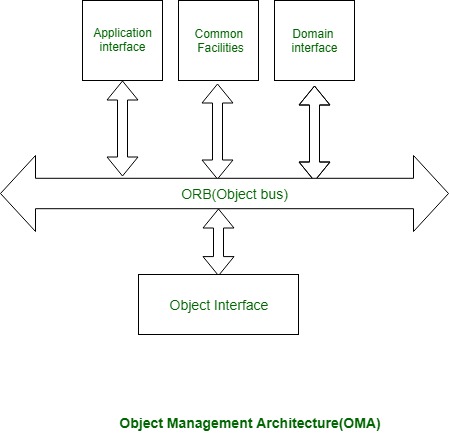Introduction to Common Object Request Broker Architecture (CORBA) – Client-Server Software Development
Last Updated :
08 Jan, 2024
Common Object Request Broker Architecture (CORBA) could be a specification of a regular design for middleware. It is a client-server software development model.
Using a CORBA implementation, a shopper will transparently invoke a way on a server object, which may air a similar machine or across a network. The middleware takes the decision, associated is to blame for finding an object that will implement the request, passing it the parameters, invoking its methodology, and returning the results of the invocation. The shopper doesn’t need to remember wherever the item is found, its programming language, its software package or the other aspects that don’t seem to be a part of the associated object’s interface.
CORBA Reference Model:
The CORBA reference model known as Object Management design (OMA) is shown below figure. The OMA is itself a specification (actually, a group of connected specifications) that defines a broad variety of services for building distributed client-server applications. Several services one may expect to search out in a very middleware product like CORBA (e.g., naming, dealings, and asynchronous event management services) are literally fixed as services within the OMA

CORBA Reference Model
Different parts communicate victimization ORB. ORB is additionally referred to as the item bus. An associate example of the application interface is a distributed document facility. In a very domain interface, it will have domain dependent services, for instance, producing domain.
Object interface has some domain freelance services:
- Naming Service:
Naming service is additionally known as a white page service. Victimization naming service server-name will be searched, and its location or address pointed out.
- Trading Service:
Commercialism service is additionally known as a yellow page service. Victimization commercialism service a selected service will be searched. This is often corresponding to looking out a service like an automobile store in a very yellow page directory.
The Broker pattern is particularly useful in helping you follow these design principles:
- Divide and conquer. The remote objects can be independently designed.
- Increase reusability. It is typically possible to design the remote objects so that other systems can use them too.
- Increase reuse. You may be able to reuse remote objects that others have created.
- Design for flexibility. The broker objects can be updated as required, or you can redirect the proxy to communicate with a different remote object.
- Design for portability. You can write clients for new platforms while still accessing brokers and remote objects on other platforms.
- Design defensively. You can provide careful assertion checking in the remote objects.
Note:
There will be different services that may be provided by object interfaces like security services, life-cycle services and then on.
Like Article
Suggest improvement
Share your thoughts in the comments
Please Login to comment...